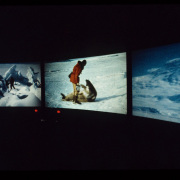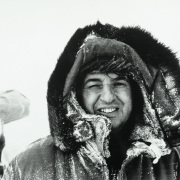Directed by Graeme Ferguson, Polar Life, shown within the sprawling Man the Explorer Pavilion on Île St-Hélène, can be understood as an experimental precursor to the panoramic spatial complexity created in IMAX films. (With Roman Kroitor, Ferguson was one of the inventors of the IMAX system, showcased at the world’s fair at Osaka in 1970.) Polar Life’s novelty was its theatre, with the audience seated on a central rotating turntable in the middle of eleven fixed screens. Viewers have described the intricate juxtaposition of screen images and narration and the complex relationship created between moving spectators and multiple screens. Documentation images and scripts of the bilingual narration by Lise Payette and Patrick Watson show elaborate temporal and spatial representations of the Arctic and Antarctic regions: the Inuit in daily activities in the Canadian North; other northern peoples of Alaska, Lapland, and Siberia; and settlers from the South, scientists, explorers, and other inhabitants of the landscape, including reindeer, bears, and birds. Archival film footage of early northern explorers, combined with newly shot documentary footage, was edited across the various screens to create spatial relationships that are sometimes coherent, sometimes fragmented. The rotating viewers viewed only three screens at a time as they moved through the domed theatre in a full rotation of twenty-eight minutes. With its overlapping screens, the duration of Polar Life was eighteen minutes.
Graeme Ferguson
Graeme Ferguson received his early training as a filmmaker in 1950 when he was selected as a student by the National Film Board of Canada. Following the presentation of Polar Life at Expo 1967, he developed what would become IMAX with Roman Kroitor, Robert Kerr and engineer, William Shaw and went on to direct and produce numerous films in the IMAX format. Ferguson has been the recipient of numerous awards and acclaim for his contributions to the film industry. He was named a member of the Order of Canada in 1993 and received honorary doctorates from the University of Bradford and Victoria University of University of Toronto.
Videos
Polar Life: Reborn excerpts
Polar Life is a film directed by Graeme Ferguson who, together with Roman Kroitor and others, invented the IMAX system that would later be showcased at the 1970 Osaka World Expo. Originally screened at the Man the Explorer pavilion, Polar Life can be understood as an experimental precursor to the panoramic spatial complexity of IMAX films.
The digital restauration of the original film was directed by Munro Ferguson, project manager. The immersive digital installation recreates the pioneering audiovisual experience of the film, Polar Life. Using advanced digital technology, a 90-degree curved screen (100% of the original visual field) and three high-definition digital projectors, the film’s digitally restored images move across 11 virtual screens that horizontally pan across the physical screen to simulate the visual experience that audiences had in 1967.
The project is the result of a partnership involving the Cinémathèque québécoise (where the original film deposited by the City of Montreal is held under the direction of Jean Gagnon, Director of Preservation and Access to Collections); Concordia and York universities via the CINEMAexpo67 research group headed by Monika Kin Gagnon, who is the installation’s curator; and the NFB, which carried out the restoration and 4K digitizing of original footage from the film. The NFB also handled the installation’s technical direction. The project was supervised by James Roberts, Assistant Director, Accessibility and Digital Enterprises, Claude Brien, Director, Technical Resources, and René Chénier, Executive Producer, all from the NFB.
Interview with Graeme Ferguson
Polar Life is the first of a series of re-creations that will lead up to the 50th anniversary in 2017 of Expo 67. Polar Life was directed by Graeme Ferguson, co-inventor of the IMAX system (with Roman Kroitor and others) that would later be showcased at the World Fair at Osaka in 1970.
The immersive digital projection installation recreates the pioneering audio-visual experience of the multi-screen film, Polar Life. Using advanced digital technology and a 90-degree curved screen representing 25% of the original circular screens, and three high-definition digital projectors (with edge-blending and warp to create a seamless single image), the digitally-restored film images move across eleven virtual screens that pan horizontally across the physical screen, simulating the visual experience that audiences had sitting in Polar Life’s rotating theatre back in 1967.
CLIPS:
In the 1st section of his interview with Scott MacKenzie, Graeme Ferguson discusses the origins of the Polar Life film project developed for Expo 67.
In the 2nd section of his interview with Scott MacKenzie, Graeme Ferguson discusses the difficulties he faced when shooting the Russian section of the Expo 67 film Polar Life.
In the 3rd section of his interview with Scott MacKenzie, Graeme Ferguson discusses the creation of the French and English voiceover developed for the Expo 67 film Polar Life.
In the 4th section of his interview with Scott MacKenzie, Graeme Ferguson discusses how he decided what he was going to shoot for the Expo 67 film Polar Life.
In the 5th section of his interview with Scott MacKenzie, Graeme Ferguson discusses the unique aesthetic and attitude towards the north that he developed in the Expo 67 film Polar Life.
The 6th and 7th clips document the discussion period following the interview between Scott MacKenzie and Graeme Ferguson regarding the Expo 67 film Polar Life.
Interview with Toni Meyers
This video gallery couldn't be loaded.
the Vimeo source for this gallery does not have any videos.
In this short clip, Monika Kin Gagnon interviews Toni Myers about her role as assistant editor on the Expo 67 film Polar Life directed by IMAX inventor Graeme Ferguson. In the interview, Toni discusses how she got involved in working on Polar Life, the technical aspects related to the complex editing of Polar Life, and what it was like to be a woman working in film at the time of Expo 67.
Toni Myers is a renowned IMAX editor and writer, known for Hubble 3D (2010), Space Station 3D (2002) and Under the Sea 3D (2009).
Polar Life: Press Conference
Polar Life is a film directed by Graeme Ferguson who, together with Roman Kroitor and others, invented the IMAX system that would later be showcased at the 1970 Osaka World Expo. Originally screened at the Man the Explorer pavilion, Polar Life can be understood as an experimental precursor to the panoramic spatial complexity of IMAX films.
The digital restauration of the original film was directed by Munro Ferguson, project manager. The immersive digital installation recreates the pioneering audiovisual experience of the film, Polar Life. Using advanced digital technology, a 90-degree curved screen (100% of the original visual field) and three high-definition digital projectors, the film’s digitally restored images move across 11 virtual screens that horizontally pan across the physical screen to simulate the visual experience that audiences had in 1967.
The project is the result of a partnership involving the Cinémathèque québécoise (where the original film deposited by the City of Montreal is held under the direction of Jean Gagnon, Director of Preservation and Access to Collections); Concordia and York universities via the CINEMAexpo67 research group headed by Monika Kin Gagnon, who is the installation’s curator; and the NFB, which carried out the restoration and 4K digitizing of original footage from the film. The NFB also handled the installation’s technical direction. The project was supervised by James Roberts, Assistant Director, Accessibility and Digital Enterprises, Claude Brien, Director, Technical Resources, and René Chénier, Executive Producer, all from the NFB.



















